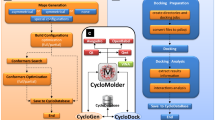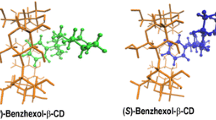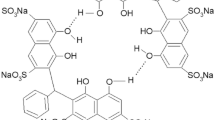Abstract
A molecular modeling study of symmetrical conformers of α-, β-, and γ-cyclodextrins in the gas and aqueous phases was carried out using the M06-2X density functional method, with SMD employed as an implicit solvation model. Eight symmetrical conformers were found for each cyclodextrin. Values of geometrical parameters obtained from the modeling study were found to agree well with those obtained from X-ray diffraction structures. A vibrational analysis using harmonic frequencies was performed to determine thermodynamic quantities. The GIAO method was applied to determine proton and carbon-13 NMR chemical shifts, which were then compared with corresponding chemical shifts reported in the literature. Hydrogen-bonding patterns were analyzed using geometrical descriptors, and quantum chemical topology was explored by QTAIM analysis. The results of this study indicated that four of the eight conformers studied for each cyclodextrin are the most populated in aqueous solution. These results provide the foundations for future studies of host–guest complexes involving these cyclodextrins.

δΔGsolvation: variation of free Gibss energy of solvation






Similar content being viewed by others
References
Szejtli J (1998) Introduction and general overview of cyclodextrin chemistry. Chem Rev 98(5):1743–1754. https://doi.org/10.1021/cr970022c
Tonkova A (1998) Bacterial cyclodextrin glucanotransferase. Enzym Microb Technol 22(8):678–686. https://doi.org/10.1016/S0141-0229(97)00263-9
Biwer A, Antranikian G, Heinzle E (2002) Enzymatic production of cyclodextrins. Appl Microbiol Biotechnol 59(6):609–617. https://doi.org/10.1007/s00253-002-1057-x
Del Valle EMM (2004) Cyclodextrins and their uses: a review. Process Biochem 39(9):1033–1046. https://doi.org/10.1016/S0032-9592(03)00258-9
Manor PC, Saenger W (1974) Topography of cyclodextrin inclusion complexes. III. Crystal and molecular structure of cyclohexaamylose hexahydrate, the water dimer inclusion complex. J Am Chem Soc 96(11):3630–3639
Steiner T, Koellner G (1994) Crystalline β-cyclodextrin hydrate at various humidities: fast, continuous, and reversible dehydration studied by X-ray diffraction. J Am Chem Soc 116(12):5122–5128
Harata K (1987) The structure of the cyclodextrin complex. XX. Crystal structure of uncomplexed hydrated γ-cyclodextrin. Bull Chem Soc Jap 60:2763–2767
Frömming K-H, Szejtli J (1994) Cyclodextrins in pharmacy, vol 5, 1st edn. Springer, Dordrecht
Loftsson T, Brewster ME (1996) Pharmaceutical applications of cyclodextrins. 1. Drug solubilization and stabilization. J Pharm Sci 85(10):1017–1025
Szejtli J (2004) Past, present and futute of cyclodextrin research. Pure Appl Chem 76(10):1825–1845
Steed J, Atwood J (2009) Supramolecular chemistry, 2nd edn. Wiley, Chichester
Connors KA (1997) The stability of cyclodextrin complexes in solution. Chem Rev 97(5):1325–1358
Rekharsky MV, Inoue Y (1998) Complexation thermodynamics of cyclodextrins. Chem Rev 98(5):1875–1918
Loftsson T, Duchêne D (2007) Cyclodextrins and their pharmaceutical applications. Int J Pharm 329(1):1–11
Juvancz Z, Kendrovics RB, Iványi R, Szente L (2008) The role of cyclodextrins in chiral capillary electrophoresis. Electrophoresis 29(8):1701–1712. https://doi.org/10.1002/elps.200700657
Dodziuk H (2006) Cyclodextrins and their complexes: chemistry, analytical methods, applications. Wiley-VCH, Weinheim
Szejtli J (ed)(1981) Advances in inclusion science. Proceedings of the First International Symposium on Cyclodextrins. Springer, Dordrecht
Szejtli J, Osa T (eds)(1996) Cyclodextrins, vol 3. Comprehensive supramolecular chemistry. Pergamon/Elsevier, Oxford
Hedges AR (1998) Industrial applications of cyclodextrins. Chem Rev 98(5):2035–2044. https://doi.org/10.1021/cr970014w
Uekama K (2002) Recent aspects of pharmaceutical application of cyclodextrins. J Incl Phenom Macrocycl Chem 44(1–4):3–7. https://doi.org/10.1023/A:1023007032444
Bilensoy E (ed)(2011) Cyclodextrins in pharmaceutics, cosmetics, and biomedicine: current and future industrial applications. Wiley, Hoboken
Stella VJ, Rajewski RA (1997) Cyclodextrins: their future in drug formulation and delivery. Pharm Res 14(5):556–567
Szente L, Szemán J (2013) Cyclodextrins in analytical chemistry: host-guest type molecular recognition. Anal Chem 85(17):8024–8030
Shao D, Sheng G, Chen C, Wang X, Nagatsu M (2010) Removal of polychlorinated biphenyls from aqueous solutions using β-cyclodextrin grafted multiwalled carbon nanotubes. Chemosphere 79(7):679–685
Fakayode SO, Lowry M, Fletcher KA, Huang X, Powe AM, Warner IM (2007) Cyclodextrins host-guest chemistry in analytical and environmental chemistry. Curr Anal Chem 3(3):171–181
Gruiz K, Molnár M, Fenyvesi E, Hajdu C, Atkári Á, Barkács K (2011) Cyclodextrins in innovative engineering tools for risk-based environmental management. J Incl Phenom Macrocycl Chem 70(3–4):299–306
Simó C, Barbas C, Cifuentes A (2003) Chiral electromigration methods in food analysis. Electrophoresis 24(15):2431–2441. https://doi.org/10.1002/elps.200305442
Cabral Marques HM (2010) A review on cyclodextrin encapsulation of essential oils and volatiles. Flavour Fragr J 25(5):313–326. https://doi.org/10.1002/ffj.2019
Schneiderman E, Stalcup AM (2000) Cyclodextrins: a versatile tool in separation science. J Chromatogr B 745(1):83–102. https://doi.org/10.1016/S0378-4347(00)00057-8
Li S, Purdy WC (1992) Cyclodextrins and their applications in analytical chemistry. Chem Rev 92(6):1457–1470
Mosinger J, Tománková V, Němcová I, Zýka J (2001) Cyclodextrins in analytical chemistry. Anal Lett 34(12):1979–2004
Muñoz de la Peña A, Mahedero M, Sánchez AB (2000) Room temperature phosphorescence in cyclodextrins. Analytical applications. Analysis 28(8):670–678
Lipkowitz KB (1998) Applications of computational chemistry to the study of cyclodextrins. Chem Rev 98(5):1829–1874. https://doi.org/10.1021/cr9700179
Maclennan JM, Stezowski JJ (1980) The crystal structure of uncomplexed-hydrated cyclooctaamylose. Biochem Biophys Res Commun 92(3):926–932
Lindner K, Saenger W (1982) Crystal and molecular structure of cyclohepta-amylose dodecahydrate. Carbohydr Res 99:103–115
Endo T, Nagase H, Ueda H, Kobayashi S, Nagai T (1997) Isolation, purification, and characterization of cyclomaltodecaose (ε-Cyclodextrin), cyclomaltoundecaose (ζ-cyclodextrin) and cyclomaltotridecaose (θ-cyclodextrin). Chem Pharm Bull 45(3):532–536. https://doi.org/10.1248/cpb.45.532
Momany FA, Willett JL (2000) Computational studies on carbohydrates: solvation studies on maltose and cyclomaltooligosaccharides (cyclodextrins) using a DFT/ab initio-derived empirical force field, AMB99C. Carbohydr Res 326(3):210–226. https://doi.org/10.1016/S0008-6215(00)00043-4
Mixcoha E, Campos-Terán J, Piñeiro Á (2014) Surface adsorption and bulk aggregation of cyclodextrins by computational molecular dynamics simulations as a function of temperature: α-CD vs β-CD. J Phys Chem B 118(25):6999–7011. https://doi.org/10.1021/jp412533b
Koehler J, Saenger W, Van Gunsteren W (1988) On the occurrence of three-center hydrogen bonds in cyclodextrins in crystalline form and in aqueous solution: comparison of neutron diffraction and molecular dynamics results. J Biomol Struct Dyn 6(1):181–198
Koehler J, Saenger W, Van Gunsteren W (1988) Conformational differences between α-cyclodextrin in aqueous solution and in crystalline form: a molecular dynamics study. J Mol Biol 203(1):241–250
Elbashir AA, Suliman FO (2011) Computational modeling of capillary electrophoretic behavior of primary amines using dual system of 18-crown-6 and β-cyclodextrin. J Chromatogr A 1218(31):5344–5351
Nascimento Jr CS, Dos Santos HF, De Almeida WB (2004) Theoretical study of the formation of the α-cyclodextrin hexahydrate. Chem Phys Lett 397(4):422–428
Anconi CPA, Nascimento CS, Fedoce-Lopes J, Dos Santos HF, De Almeida WB (2007) Ab initio calculations on low-energy conformers of α-cyclodextrin. J Phys Chem A 111(48):12127–12135. https://doi.org/10.1021/jp0762424
Snor W, Liedl E, Weiss-Greiler P, Karpfen A, Viernstein H, Wolschann P (2007) On the structure of anhydrous β-cyclodextrin. Chem Phys Lett 441(1):159–162
Pinjari RV, Joshi KA, Gejji SP (2006) Molecular electrostatic potentials and hydrogen bonding in α-, β-, and γ-cyclodextrins. J Phys Chem A 110(48):13073–13080
Pinjari RV, Joshi KA, Gejji SP (2007) Theoretical studies on hydrogen bonding, NMR chemical shifts and electron density topography in α, β and γ-cyclodextrin conformers. J Phys Chem A 111(51):13583–13589. https://doi.org/10.1021/jp074539w
Karpfen A, Liedl E, Snor W, Weiss-Greiler P, Viernstein H, Wolschann P (2007) Homodromic hydrogen bonds in low-energy conformations of single molecule cyclodextrins. J Incl Phenom Macrocycl Chem 57(1–4):35–38
Jiménez V, Alderete JB (2008) Hartree−Fock and density functional theory study of α-cyclodextrin conformers. J Phys Chem A 112(4):678–685. https://doi.org/10.1021/jp073011o
Deshmukh MM, Bartolotti LJ, Gadre SR (2011) Intramolecular hydrogen bond energy and cooperative interactions in α-, β-, and γ-cyclodextrin conformers. J Comput Chem 32(14):2996–3004. https://doi.org/10.1002/jcc.21881
Stachowicz A, Styrcz A, Korchowiec J, Modaressi A, Rogalski M (2011) DFT studies of cation binding by β-cyclodextrin. Theor Chem Acc 130(4):939–953
Jaiyong P, Bryce RA (2017) Approximate quantum chemical methods for modelling carbohydrate conformation and aromatic interactions: β-cyclodextrin and its adsorption on a single-layer graphene sheet. Phys Chem Chem Phys 19:15346–15355
Zhao Y, Truhlar DG (2008) The M06 suite of density functionals for main group thermochemistry, thermochemical kinetics, noncovalent interactions, excited states, and transition elements: two new functionals and systematic testing of four M06-class functionals and 12 other functionals. Theor Chem Acc 120(1):215–241
Stewart JJP (2007) Optimization of parameters for semiempirical methods. V: Modification of NDDO approximations and application to 70 elements. J Mol Model 13:1173–1213. https://doi.org/10.1007/s00894-007-0233-4
Grimme S, Antony J, Ehrlich S, Krieg H (2010) A consistent and accurate ab initio parametrization of density functional dispersion correction (DFT-D) for the 94 elements H–Pu. J Chem Phys 132(15):154104
Řezáč J, Hobza P (2011) Advanced corrections of hydrogen bonding and dispersion for semiempirical quantum mechanical methods. J Chem Theory Comput 8(1):141–151
Stewart JJP (2016) MOPAC2016 v16.125W. Stewart Computational Chemistry, Colorado Springs
Grimme S, Ehrlich S, Goerigk L (2011) Effect of the damping function in dispersion corrected density functional theory. J Comput Chem 32(7):1456–1465. https://doi.org/10.1002/jcc.21759
Marenich AV, Cramer CJ, Truhlar DG (2009) Universal solvation model based on solute electron density and on a continuum model of the solvent defined by the bulk dielectric constant and atomic surface tensions. J Phys Chem B 113(18):6378–6396
Frisch MJ, Trucks GW, Schlegel HB, Scuseria GE, Robb MA, Cheeseman JR, Scalmani G, Barone V, Mennucci B, Petersson GA, Nakatsuji H, Caricato M, Li X, Hratchian HP, Izmaylov AF, Bloino J, Zheng G, Sonnenberg JL, Hada M, Ehara M, Toyota K, Fukuda R, Hasegawa J, Ishida M, Nakajima T, Honda Y, Kitao O, Nakai H, Vreven T, Montgomery Jr JA, Peralta JE, Ogliaro F, Bearpark M, Heyd JJ, Brothers E, Kudin KN, Staroverov VN, Kobayashi R, Normand J, Raghavachari K, Rendell A, Burant JC, Iyengar SS, Tomasi J, Cossi M, Rega N, Millam JM, Klene M, Knox JE, Cross JB, Bakken V, Adamo C, Jaramillo J, Gomperts R, Stratmann RE, Yazyev O, Austin AJ, Cammi R, Pomelli C, Ochterski JW, Martin RL, Morokuma K, Zakrzewski VG, Voth GA, Salvador P, Dannenberg JJ, Dapprich S, Daniels AD, Farkas O, Foresman JB, Ortiz JV, Cioslowski J, Fox DJ (2013) Gaussian 09, revision E.01. Gaussian, Inc., Wallingford
London F (1937) Théorie quantique des courants interatomiques dans les combinaisons aromatiques. J Phys Radium 8(10):397–409
Young DC (2001) Computational chemistry: a practical guide for applying techniques to real-world problems. Wiley, New York
Rablen PR, Pearlman SA, Finkbiner J (1999) A comparison of density functional methods for the estimation of proton chemical shifts with chemical accuracy. J Phys Chem A 103(36):7357–7363
Sebag AB, Forsyth DA, Plante MA (2001) Conformation and configuration of tertiary amines via GIAO-derived 13C NMR chemical shifts and a multiple independent variable regression analysis. J Org Chem 66(24):7967–7973
Brown I (1976) On the geometry of O–H⋯O hydrogen bonds. Acta Crystallogr Sect A 32(1):24–31
Ferraris G, Ivaldi G (1988) Bond valence vs bond length in O⋯O hydrogen bonds. Acta Crystallogr Sect B 44(4):341–344
Smallwood CJ, McAllister MA (1997) Characterization of low-barrier hydrogen bonds. 7. Relationship between strength and geometry of short-strong hydrogen bonds. The formic acid− formate anion model system. An ab initio and DFT investigation. J Am Chem Soc 119(46):11277–11281
Grabowski SJ (2004) Hydrogen bonding strength—measures based on geometric and topological parameters. J Phys Org Chem 17(1):18–31
Bader RFW (1994) Atoms in molecules: a quantum theory, vol 22, 1st edn. Clarendon, Oxford
Nakanishi W, Hayashi S, Narahara K (2008) Atoms-in-molecules dual parameter analysis of weak to strong interactions: behaviors of electronic energy densities versus Laplacian of electron densities at bond critical points. J Phys Chem A 112(51):13593–13599. https://doi.org/10.1021/jp8054763
Nakanishi W, Hayashi S, Narahara K (2009) Polar coordinate representation of H b(r c) versus (ℏ2/8m)▽2 ρ b(r c) at BCP in AIM analysis: classification and evaluation of weak to strong interactions. J Phys Chem 113:10050–10057. https://doi.org/10.1021/jp903622a
Kitagawa M, Hoshi H, Sakurai M, Inoue Y, Chûjô R (1987) The large dipole moment of cyclomaltohexaose and its role in determining the guest orientation in inclusion complexes. Carbohydr Res 163(1):c1–c3
Sakurai M, Kitagawa M, Hoshi H, Inoue Y, Chûjô R (1990) A molecular orbital study of cyclodextrin (cyclomalto-oligosaccharide) inclusion complexes. III: Dipole moments of cyclodextrins in various types of inclusion complex. Carbohydr Res 198(2):181–191
Rajendiran N, Sankaranarayanan R (2014) Azo dye/cyclodextrin: new findings of identical nanorods through 2:2 inclusion complexes. Carbohydr Polym 106:422–431
Schneider H-J, Hacket F, Volker R, Ikeda H (1998) NMR studies of cyclodextrins and cyclodextrin complexes. Chem Rev 98:1755–1785
Giesen DJ, Zumbulyadis N (2002) A hybrid quantum mechanical and empirical model for the prediction of isotropic 13C shielding constants of organic molecules. Phys Chem Chem Phys 4(22):5498–5507
Saenger W, Steiner T (1998) Cyclodextrin inclusion complexes: host–guest interactions and hydrogen-bonding networks. Acta Crystallogr Sect A 54(6):798–805
Gamboa-Carballo JJ, Melchor-Rodríguez K, Hernández-Valdés D, Enriquez-Victorero C, Montero-Alejo AL, Gaspard S, Jáuregui-Haza UJ (2016) Theoretical study of chlordecone and surface groups interaction in an activated carbon model under acidic and neutral conditions. J Mol Graph Model 65:83–93. https://doi.org/10.1016/j.jmgm.2016.02.008
Acknowledgements
Computational calculations were performed using Wahoo, the cluster of the Centre Commun de Calcul Intensif of the Université des Antilles, Guadeloupe, France. Several calculations were run in the computer clusters Brutus and Euler at ETH, Zürich, Switzerland. The informatics service at InSTEC, Havana, Cuba is gratefully acknowledged for allowing communications with calculation centers overseas. The authors also wish to express their gratitude for the financial support provided by the project TATARCOP-InSTEC, Havana, and to the Cooperation Service of the French Embassy in Havana, Cuba.
Author information
Authors and Affiliations
Corresponding author
Electronic supplementary material
ESM 1
(DOCX 398 kb)
Rights and permissions
About this article
Cite this article
Gamboa-Carballo, J.J., Rana, V.K., Levalois-Grützmacher, J. et al. Structures and stabilities of naturally occurring cyclodextrins: a theoretical study of symmetrical conformers. J Mol Model 23, 318 (2017). https://doi.org/10.1007/s00894-017-3488-4
Received:
Accepted:
Published:
DOI: https://doi.org/10.1007/s00894-017-3488-4




